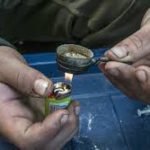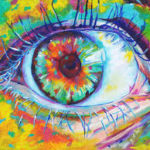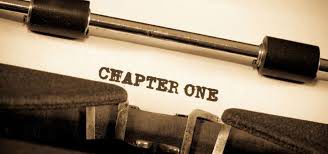Hi again. I know I haven’t been posting much lately, but it’s time to get back on that horse. One thing I did in the interim was write a chapter for a volume on addiction. Which led to a strange conundrum…and some soul searching.
But before getting to that, I’ll tell you what inspired me to keep blogging for now. First, I opened Google Analytics and found that I’m still getting 200 hits per day…even after weeks with no new posts. People remain interested in our alternative and progressive approach to addiction. Wonderful! Second: I met Sandy P at my father’s memorial in California last week. And she told me she not only still exists but she follows my blog. Amazing. Sandy was my brother’s girlfriend, and Abbie, her next-door neighbour, was mine, when we were in our late teens. (When I was first getting into drugs, Abbie was my salvation. Until I took off for Asia: no Abbie, lots of drugs.) Thanks, Sandy, for a sweet hit of nostalgia.
 Now about that chapter. I’ve had papers rejected by publications lots of times. It’s part of the rat race of being an academic, a researcher, submitting your best work to journals, waiting for the letter from the editor, finally getting that heart-stopping email and reading it and Oh Shit! They’re rejecting it?! Without even a “revise and resubmit!” Damn ignorant asshole editors. Too good for your shitty journal anyway… Then the anger and disappointment start to evaporate and you start thinking about what journal to send it to next. That’s the life of an academic. And that’s one reason I was glad to be done with it, and why, about eight months ago, I swore to myself I was done with academic writing.
Now about that chapter. I’ve had papers rejected by publications lots of times. It’s part of the rat race of being an academic, a researcher, submitting your best work to journals, waiting for the letter from the editor, finally getting that heart-stopping email and reading it and Oh Shit! They’re rejecting it?! Without even a “revise and resubmit!” Damn ignorant asshole editors. Too good for your shitty journal anyway… Then the anger and disappointment start to evaporate and you start thinking about what journal to send it to next. That’s the life of an academic. And that’s one reason I was glad to be done with it, and why, about eight months ago, I swore to myself I was done with academic writing.
But I caved. A colleague in Toronto, an addiction doctor, urged me to write a chapter for a book for addiction doctors, to spell out my learning model of addiction, and how it reconceptualizes the data on brain change in addiction, for the benefit of…well, addiction doctors. Because, even though they’re doctors, they don’t necessarily buy the disease model of addiction. At least they don’t necessarily buy all of it, or maybe they’re uncomfortable with it, or maybe, just maybe, the field is changing. (This particular doctor specializes in ACT for his patients.)
 So I wrote the chapter. Took pieces from other work, revised them, wrote some new stuff, trying to make it accessible for all those doctors out there, because they don’t really understand human development very well and they sure don’t understand psychology very well. So, why not give them the benefit of my stratospheric perspective. (LOL) I spent a couple of weeks working pretty hard, sent it in, and soon heard back from the editor. Thank you for submitting your chapter for publication in “A prescriber’s guide to methadone and buprenorphine for opioid use disorder…” Which is when I said to myself, those ignorant editors! They got the wrong book. Or the wrong title. Or something. I can’t write a chapter that urges ditching the medical model for a damn prescriber’s guide!
So I wrote the chapter. Took pieces from other work, revised them, wrote some new stuff, trying to make it accessible for all those doctors out there, because they don’t really understand human development very well and they sure don’t understand psychology very well. So, why not give them the benefit of my stratospheric perspective. (LOL) I spent a couple of weeks working pretty hard, sent it in, and soon heard back from the editor. Thank you for submitting your chapter for publication in “A prescriber’s guide to methadone and buprenorphine for opioid use disorder…” Which is when I said to myself, those ignorant editors! They got the wrong book. Or the wrong title. Or something. I can’t write a chapter that urges ditching the medical model for a damn prescriber’s guide!
As mentioned, I’ve had my work rejected by numerous publications. But this was the first time I rejected the publication. Even after I’d done all the work. Even when they said Yes, we want it! I wrote back and said, I’m sorry but I can’t contribute a chapter to a prescriber’s guide, or to anything called a prescriber’s guide. Because if the whole point of the book is to get a better handle on prescribing methadone and buprenorphine, then GO AHEAD AND CALL IT A DISEASE! Why not?
My colleague hadn’t told me that this “book for addiction doctors” would be entitled a prescriber’s guide to anything. Maybe he didn’t know. He emailed  me after I withdrew my submission and said: Addiction doctors prescribe opioid substitutes to 95% of their opioid-addicted patients. Like: duh…didn’t I know that? Yes, I knew that, more or less. And I knew that
me after I withdrew my submission and said: Addiction doctors prescribe opioid substitutes to 95% of their opioid-addicted patients. Like: duh…didn’t I know that? Yes, I knew that, more or less. And I knew that  opioid addicts are often in desperate need of opioid substitution therapy (OST). It helps them get off the street and sometimes stay off, it relieves the overwhelming anxiety of withdrawal, and it saves lives. As Maia Szalavitz often reports, it’s the only evidence-based treatment that saves lives. And of course that’s because heroin, especially when it’s laced with or replaced by fentanyl or its analogues, can be deadly.
opioid addicts are often in desperate need of opioid substitution therapy (OST). It helps them get off the street and sometimes stay off, it relieves the overwhelming anxiety of withdrawal, and it saves lives. As Maia Szalavitz often reports, it’s the only evidence-based treatment that saves lives. And of course that’s because heroin, especially when it’s laced with or replaced by fentanyl or its analogues, can be deadly.
So why would I avoid being featured in such a book? Maybe I should have just swallowed my whatever and revised the chapter. All those words distinguishing physiological dependency from addiction (which I maintain is a psychological process)…they would have to go. And so would that pep talk about listening to the person, not the diagnosis, and using your counselling skills, your human skills, to reach beyond just prescribing. I’d have to shelve  all that. I fully advocate the use of methadone and Suboxone. I agree with other progressive addiction specialists (e.g., Mark Willenbring) that they should be easily available wherever they’re needed, free of cost, free of line-ups, free of stigma. But I’ve got nothing to contribute to that argument. Right?
all that. I fully advocate the use of methadone and Suboxone. I agree with other progressive addiction specialists (e.g., Mark Willenbring) that they should be easily available wherever they’re needed, free of cost, free of line-ups, free of stigma. But I’ve got nothing to contribute to that argument. Right?
Can we social-development-oriented “addiction specialists” refute the disease model and still advocate OST?
 I told myself I’m trying go avoid an awkward irony: that there’s maybe one good reason to call addiction a disease. In the US and Canada it’s the only way to get addicts their medicine, their heroin substitutes. I’ve thought about this
I told myself I’m trying go avoid an awkward irony: that there’s maybe one good reason to call addiction a disease. In the US and Canada it’s the only way to get addicts their medicine, their heroin substitutes. I’ve thought about this  lots. But I remain concerned and confused. Maybe “medicalization” is the best we can do for people who are in a real jam, on the street or close to it, hunting for heroin day by day. Yet it maintains, in fact it strengthens, the premise that these people are sick, and it sidelines all the familial, social, economic, and cultural forces that pushed them into that lifestyle in the first place.
lots. But I remain concerned and confused. Maybe “medicalization” is the best we can do for people who are in a real jam, on the street or close to it, hunting for heroin day by day. Yet it maintains, in fact it strengthens, the premise that these people are sick, and it sidelines all the familial, social, economic, and cultural forces that pushed them into that lifestyle in the first place.
Somehow these two perspectives on opioid addiction have got to come together. At least in the present social climate. But I’m at a loss as to how to help that happen.
Or maybe it’s simple. Maybe we just need one or two catchphrases to merge these two approaches: phrases like “harm reduction,” or maybe “working with the individual where they’re at.” In my next post, I’ll tell you about a treatment program in New York City where that kind of conceptualization governs everything they do. I gave a talk there two weeks ago, met some fabulous people, and learned how the field is changing. Stay tuned.


 With addiction, you think this thing, this substance (let’s say a few lines of coke) is valuable and special. And you feel the excitement of anticipation — soon I’m gonna have some. Then you feel the buzz, and doesn’t that feel great? Which strengthens the image, the conception, that coke is valuable and special. See how the thought/image and the feeling (both before and during) fuel each other? Which is why it’s so hard to say No thanks, not tonight.
With addiction, you think this thing, this substance (let’s say a few lines of coke) is valuable and special. And you feel the excitement of anticipation — soon I’m gonna have some. Then you feel the buzz, and doesn’t that feel great? Which strengthens the image, the conception, that coke is valuable and special. See how the thought/image and the feeling (both before and during) fuel each other? Which is why it’s so hard to say No thanks, not tonight. So what does the addictive substance or act symbolize? To me, that’s the big question. The longer I practice psychotherapy with people in addiction, the more convinced I am that each person constructs his or her own scenario, vignette, drama, diorama — I don’t know what to call it — based on what went wrong or what went missing in childhood or adolescence. I introduced this idea last post, in terms of diving into the child self-narrative. Here I want to get into the details: what’s the narrative about?
So what does the addictive substance or act symbolize? To me, that’s the big question. The longer I practice psychotherapy with people in addiction, the more convinced I am that each person constructs his or her own scenario, vignette, drama, diorama — I don’t know what to call it — based on what went wrong or what went missing in childhood or adolescence. I introduced this idea last post, in terms of diving into the child self-narrative. Here I want to get into the details: what’s the narrative about? she was achingly lonely. But when she went into her closet and cut little red lines in her forearm, she felt free, she felt vital, she was unobserved, she didn’t need or seek permission, she felt defiant, and most of all she felt in control of her own feelings. That’s what the cutting meant to her then. And that’s almost exactly what coke means to her now, decades later.
she was achingly lonely. But when she went into her closet and cut little red lines in her forearm, she felt free, she felt vital, she was unobserved, she didn’t need or seek permission, she felt defiant, and most of all she felt in control of her own feelings. That’s what the cutting meant to her then. And that’s almost exactly what coke means to her now, decades later.  She scampers into the bathroom, leaving the other ladies chatting over wine or coffee, and does a couple of lines. Again, she’s on her own, released, free, defiant, and in control of what she’s feeling. Now take that symbolic scenario she’s created, and graft it onto the feeling of the anticipation and then the feeling of the rush itself. That cognition-emotion linkage has been reinforced thousands of times. It’s not going to go away easily.
She scampers into the bathroom, leaving the other ladies chatting over wine or coffee, and does a couple of lines. Again, she’s on her own, released, free, defiant, and in control of what she’s feeling. Now take that symbolic scenario she’s created, and graft it onto the feeling of the anticipation and then the feeling of the rush itself. That cognition-emotion linkage has been reinforced thousands of times. It’s not going to go away easily. with my armful of chips. Now couple that image with the sheer excitement of not knowing how the next hand will turn out. (That’s a big deal for gamblers.) The image and the feeling fuse — possibly forever.
with my armful of chips. Now couple that image with the sheer excitement of not knowing how the next hand will turn out. (That’s a big deal for gamblers.) The image and the feeling fuse — possibly forever. A couple of my clients have combined drugs, sex or sexting, and/or porn into this incredibly artful (what else to call it?) ritual — a scenario in which they are desirable, desired, potent, free, and safe. The experience they’re addicted to is basically a fantasy of being both very good and very bad, nasty and safe at the same time — the dream fantasy of a child or young teenager. But here’s the thing: the components — the coke and the porn for example — are only valuable in how they contribute to this symbolic amalgam. What each offers, without that symbolic currency, is almost nothing at all.
A couple of my clients have combined drugs, sex or sexting, and/or porn into this incredibly artful (what else to call it?) ritual — a scenario in which they are desirable, desired, potent, free, and safe. The experience they’re addicted to is basically a fantasy of being both very good and very bad, nasty and safe at the same time — the dream fantasy of a child or young teenager. But here’s the thing: the components — the coke and the porn for example — are only valuable in how they contribute to this symbolic amalgam. What each offers, without that symbolic currency, is almost nothing at all. So I’ve got a prescription for some pretty powerful opioids. And as soon as I pop one or two, the whole symbolic vignette from my days of addiction returns. I get to make myself warm and safe, I get to be taken care of, like when I was sick as a child — come here, Mommy, I need you — and I get to control all that with
So I’ve got a prescription for some pretty powerful opioids. And as soon as I pop one or two, the whole symbolic vignette from my days of addiction returns. I get to make myself warm and safe, I get to be taken care of, like when I was sick as a child — come here, Mommy, I need you — and I get to control all that with  these little objects — the pills — which are mine! (particularly handy if Mom isn’t feeling very connected). That symbolism is so much more powerful than the feeling the drug provides. Yet the drug does provide a feeling…a warmth in my stomach, a vague but familiar sense of pleasure. What I’m saying is that this feeling is pretty nice (though I know it will collapse into boredom soon enough), but its power lies in how it holds the symbolic scenario in place.
these little objects — the pills — which are mine! (particularly handy if Mom isn’t feeling very connected). That symbolism is so much more powerful than the feeling the drug provides. Yet the drug does provide a feeling…a warmth in my stomach, a vague but familiar sense of pleasure. What I’m saying is that this feeling is pretty nice (though I know it will collapse into boredom soon enough), but its power lies in how it holds the symbolic scenario in place. But man, do I ever get what it’s like, for my addicted clients, and for almost anyone fighting that so-powerful amalgam of thought and feeling: the fabricated scene, the sense of completeness, the revised reality, and the control you take (or at least hope for) — an entrenched (but fantasized) improvement over what it was really like to be young and scared, alone and helpless.
But man, do I ever get what it’s like, for my addicted clients, and for almost anyone fighting that so-powerful amalgam of thought and feeling: the fabricated scene, the sense of completeness, the revised reality, and the control you take (or at least hope for) — an entrenched (but fantasized) improvement over what it was really like to be young and scared, alone and helpless.
 expectations. I’d anticipate going home, dismissing my own needs, and catering to hers. Really I was going back to my “false self” — a term borrowed from psychoanalytic theory — which means being fake and imagining that the fake you is the real you. I tried being sensitive, solicitous, responsible, accommodating. I felt trapped in this role — a third self-narrative? I couldn’t see a way out. So I managed to change selves. I’d get those first glimmerings…why don’t I get some drugs and get high and of course hide it, not only from my wife but from everyone. It will be my secret — it’s always been my secret. Except when things went really wrong, like the time I woke up on a
expectations. I’d anticipate going home, dismissing my own needs, and catering to hers. Really I was going back to my “false self” — a term borrowed from psychoanalytic theory — which means being fake and imagining that the fake you is the real you. I tried being sensitive, solicitous, responsible, accommodating. I felt trapped in this role — a third self-narrative? I couldn’t see a way out. So I managed to change selves. I’d get those first glimmerings…why don’t I get some drugs and get high and of course hide it, not only from my wife but from everyone. It will be my secret — it’s always been my secret. Except when things went really wrong, like the time I woke up on a  sofa in the student union lounge suffocating on what seemed poison gas. That unholy smell was burning upholstery. The sofa was on fire from the cigarette I’d dropped while nodding out. Or the times I got busted, fired, or kicked out of school.
sofa in the student union lounge suffocating on what seemed poison gas. That unholy smell was burning upholstery. The sofa was on fire from the cigarette I’d dropped while nodding out. Or the times I got busted, fired, or kicked out of school. Here’s my point: when I switched to my drug-taking self, everything changed in my emotional world. I felt free and I felt real. I knew that I was in deep shit in my life, in my marriage, in every index of adult functioning. But! In this self-narrative, I was a bad boy who would get away with something, as I had before, as I would again, until…maybe until I got caught or until the rules changed. I willingly went after the freedom I gained from “being bad” — which is pretty much the label I attached to my drug-seeking.
Here’s my point: when I switched to my drug-taking self, everything changed in my emotional world. I felt free and I felt real. I knew that I was in deep shit in my life, in my marriage, in every index of adult functioning. But! In this self-narrative, I was a bad boy who would get away with something, as I had before, as I would again, until…maybe until I got caught or until the rules changed. I willingly went after the freedom I gained from “being bad” — which is pretty much the label I attached to my drug-seeking. There’s a lot more to say about this choice. We know that most addicts had difficult childhoods of one kind or another; they could not be the children (or teens) they really were yet fit the world of adult expectations. In the dissociation of self-narratives that comes with addiction, we become those unruly children once again.
There’s a lot more to say about this choice. We know that most addicts had difficult childhoods of one kind or another; they could not be the children (or teens) they really were yet fit the world of adult expectations. In the dissociation of self-narratives that comes with addiction, we become those unruly children once again.

 stop trying so hard to unify them? Because sometimes…you just can’t. They simply don’t fit. And the effort to weld them together can be overwhelming, soul-destroying, can leave us feeling more fragmented than we already were. The
stop trying so hard to unify them? Because sometimes…you just can’t. They simply don’t fit. And the effort to weld them together can be overwhelming, soul-destroying, can leave us feeling more fragmented than we already were. The  infamous “dry drunk” is one victim of this misguided struggle.
infamous “dry drunk” is one victim of this misguided struggle. Or who I expect to become — a very different way to frame a future self!
Or who I expect to become — a very different way to frame a future self! to get high, being determined, being defiant about getting high. (Even in the world of “normies,” there are parts that don’t fit the narrative.) Maybe it’s best so see these as strands of the self-story that truly aren’t compatible with the rest. Maybe they are “clips” (when we actually bother to see them at all), but not self-stories per se. In fact, maybe their incompleteness reflects this. Maybe those strands are “doomed” to remain incomplete.
to get high, being determined, being defiant about getting high. (Even in the world of “normies,” there are parts that don’t fit the narrative.) Maybe it’s best so see these as strands of the self-story that truly aren’t compatible with the rest. Maybe they are “clips” (when we actually bother to see them at all), but not self-stories per se. In fact, maybe their incompleteness reflects this. Maybe those strands are “doomed” to remain incomplete.
 also a plumber, or I’m also hot! Okay, but that stuff is easy. Multiple self-narratives are particularly challenging for addicts, because they fit together so poorly. There’s the self that often gets called the “addict self.” There’s this me who was abused, or thrown out, or traumatized in adolescence, and all I could find to feel better was this or that
also a plumber, or I’m also hot! Okay, but that stuff is easy. Multiple self-narratives are particularly challenging for addicts, because they fit together so poorly. There’s the self that often gets called the “addict self.” There’s this me who was abused, or thrown out, or traumatized in adolescence, and all I could find to feel better was this or that  drug, so that’s what I go after. That’s one “addict self.” There are others that aren’t so benign. There’s the “I’m such a loser” version — very common, very hard to shake. Or its close cousin: “
drug, so that’s what I go after. That’s one “addict self.” There are others that aren’t so benign. There’s the “I’m such a loser” version — very common, very hard to shake. Or its close cousin: “ So here’s what I want to suggest. Bump up a level. Recognize that you do contain distinct, incompatible self-narratives. Create an uber-narrative that allows for each component narrative and doesn’t have to shut any of them down. Now you can let yourself get to know each of these self-narratives. Make each one conscious, talk it out, recount the plot-line, to yourself or others, write about it. But realize that they will not blend into one nice story. Bump up a level to a more insightful, wiser self who recognizes each of these radically different story
So here’s what I want to suggest. Bump up a level. Recognize that you do contain distinct, incompatible self-narratives. Create an uber-narrative that allows for each component narrative and doesn’t have to shut any of them down. Now you can let yourself get to know each of these self-narratives. Make each one conscious, talk it out, recount the plot-line, to yourself or others, write about it. But realize that they will not blend into one nice story. Bump up a level to a more insightful, wiser self who recognizes each of these radically different story  lines as real…and lets them coexist.
lines as real…and lets them coexist.